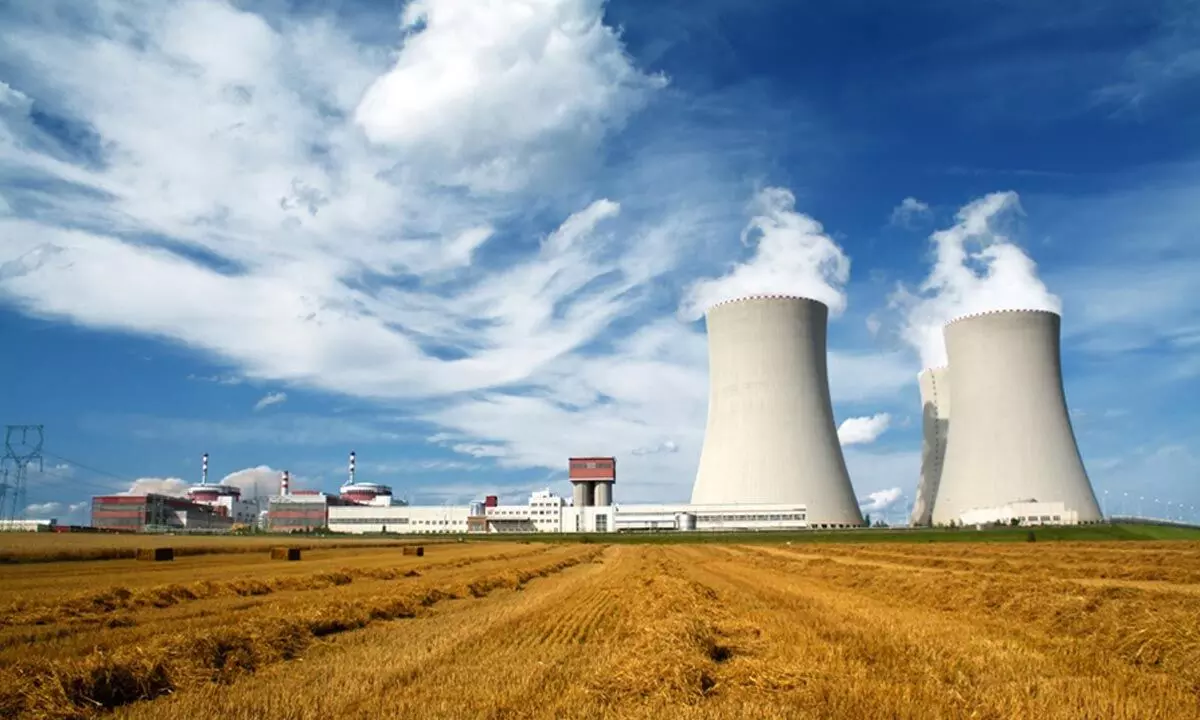Centre to take up Kovvada Nuke Project on a fast-track mode
NPCIL to generate 6,600 MW in an area of over 2,000 acres in Srikakulam district of AP
image for illustrative purpose

The employment potential during construction will follow a bell curve with about 8,000 persons at the peak. On becoming operational, each of the twin unit stations is expected to generate employment (direct and indirect) for about 2,000 persons
Visakhapatnam: The Kovvada Nuclear Power Plant project may gather some steam soon with the Central Government deciding to set it up in Srikakulam district of Andhra Pradesh on a fast-track basis.
The Government of India has already resolved to triple nuclear power over the next decade as part of a policy to generate more power from cleaner sources. The Kovvada Power Plant was proposed in 2015 to generate 6,600 MW in an area of over 2,000 acres by Nuclear Power Corporation of India Limited (NPCIL), which was strongly opposed by the Opposition parties and trade unions. Local fishermen also organised protest programmes alleging that the project to set up a six gigawatt Light Water Reactor Plant will cause a humanitarian disaster in the region.
Prime Minister Narendra Modi has set a target to achieve zero carbon emissions by 2070. Presently, India produces 70 per cent of power from coal and a meagre 3 per cent from nuclear sources and allowed State-owned NPCIL to improve its capacity substantially.
Though the Kovvada project is not new, land acquisition problems as well as bankruptcy faced by Westinghouse which promised to supply nuclear power reactors led to inordinate delay in grounding of the project.
"We will implement the project on a top priority basis as nuclear power is environment-friendly by sorting out the issues," BJP national spokesperson and MP GVL Narasimha Rao told Bizz Buzz. There are 22 nuclear power plants in operation in the country. NTPC is the latest Maharatna company, which has announced its intention to foray into nuclear power production.
In response to a question by Narasimha Rao, Union Minister Jitendra Singh told the Rajya Sabha on behalf of the Prime Minister recently that at present, there are 11 reactors under construction/ commissioning at various stages (including Kakrapar Atomic Power Plant (KAPP)-3, which is already connected to the grid and (Prototype Fast Breeder Reactor (PFBR) being implemented by Bharatiya Nabhikiya Vidyut Nigam Ltd (BHAVINI). In addition, the government has accorded administrative approval and financial sanction for 10 reactors to be set up in fleet mode.
The Minister said the government has accorded 'In-principle' approval for locating six reactors of 1,208 MW each at Kovvada in Andhra Pradesh. The cost and investment details would emerge on finalization of the project proposal and accord of administrative approval and financial sanction of the Kovvada project by the government, he stated in reply.
In respect of employment, during construction, large numbers of contractor manpower are employed. The employment potential during construction will follow a bell curve with about 8,000 persons at the peak. On becoming operational, each of the twin unit stations is expected to generate employment (direct and indirect) for about 2,000 persons.
In addition, large employment potential is generated with the contractors/ vendors and from business opportunities that emerge consequent to the increase in economic activity at the site.
In Uttar Pradesh, two indigenous Pressurized Heavy Water Reactors (PHWRs) of 220 MW capacity each Narora Atomic Power Station (NAPS)-1&2, are in operation at Narora in Bulandshahr district. The total investment on the date of commissioning of NAPS-1&2 (2X220 MW) was Rs 745 crore. These reactors provide employment to about 2,000 persons (direct and indirect).
The government claims significant employment potential has been generated with the contractors/ vendors and from business opportunities that have emerged consequent to the increase in economic activity at the site.

